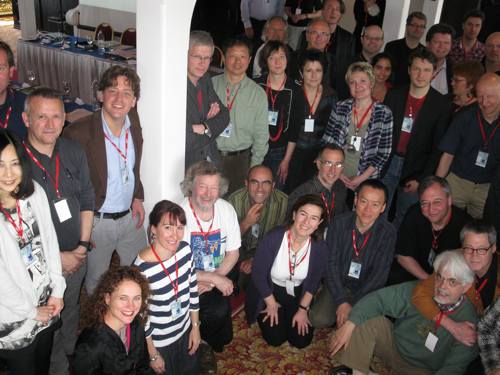We are now into the second day of the International Society for Contemporary Music’s annual World New Music Days (ISCM WNMD for short), which this year is taking place during the Zagreb Biennale in Zagreb, Croatia. I arrived in Zagreb yesterday morning via Munich. There are no direct flights from New York City despite Zagreb emerging as a major tourist spot over the past decade. The Zagreb Biennale is now celebrating its 50th anniversary—it is the longest-running new music festival in this part of the world.
There has not been a single moment of down time thus far. At 4 p.m. yesterday there was a brief formal reception welcoming delegates, most of them composers, who have come here from six continents. It is indeed a world new music event. I’m happy to report that there will be performances of works by six composers from the United States later this week—a composition for tuba quartet by Julie Harting, jazz big band pieces by Randy Bauer and Steve Wiest, plus works by B. J. Brooks, Brian Fennelly, and Melinda Wagner which will be performed by the Croatian Armed Forces Symphonic Wind Orchestra. But that’s later in the week.
After the reception last night there were two very different concerts. The first was an all-percussion extravaganza showcasing works by six composers. I was particularly intrigued by Couple by Norio Fukushi from Japan. It began as an extremely austere and introspective duet for unpitched percussion and gradually morphed into flamboyant, over-the-top zaniness with balloons popping, various children’s toys making animal sounds, and additional percussionists appearing in the audience seemingly out of nowhere. And this morning I find myself still mesmerized by Sergey Khismatov’s Cymbals Quartet, a harsh, sometimes excruciating exploration of bowing the sides of cymbals—quite a powerful sound, but not for the faint of heart.
After that concert we were all bussed to the headquarters of Radio/TV Croatia for the second concert. Radio/TV Croatia still has its own symphony orchestra, as well as the group we heard last night which was a tamburitza orchestra. The tamburitza is a plucked string instrument somewhat akin to the mandolin. The program consisted of nine short works, all but one of which was written expressly for these instruments. The sole transcription—Zaboravljene muzike (a.k.a. Forgotten Musics)—was so effectively translated to the sounds of the tamburitza by Siniša Leopold (who also conducted the orchestra) that it is difficult for me to imagine what it was originally composed for (the notes did not say). All of the music for tamburitza orchestra was composed by Croatian composers except for the very last piece, And the Strings Resound…, a work by a young Hong Kong-based composer named Dic-Lun Fung whose music I first heard back in September during the Gaudeamus Music Week. Having a work for this very Croatian ensemble by a composer from so far away was a real treat, and the ensemble approached the piece with a great deal of enthusiasm. The piece followed a work by Ivo Josipović who is currently the president of Croatia; a tough act to follow especially considering what a cool piece it was as well, but Dic-Lun Fung’s work held up nicely and introduced some unusual new timbral possibilities for the tamburitzas.
This morning began at 9 a.m. sharp with the first day of meetings of the delegates. These will take place for four hours every day this week followed by concerts in the afternoon. It was extremely exciting to be sitting alongside composers representing their parts of the world from places as far afield as Chile, the Sichuan Province in China, and even the Faroe Islands which this morning was voted in as an official member of the network. Joining me from the United States are David McMullin, based in Boston, and Stephen Lias from Texas. Orlando Jacinto Garcia from Florida and William Anderson from New York City are also involved but were unable to attend. It would be wonderful if more Americans could participate in this organization, which offers an opportunity for performances that will be heard by composers and new music aficionados from all over the planet.
Our meetings ended early this morning so we could all have a private audience with Croatian President Ivo Josipović who still actively composes music—no excuses not to make time to compose for any of us who have to maintain day jobs in order to earn a living! Josipović used to head the Croatian Composers Society as well as the Zagreb Biennale, and he is still very much interested in being part of this scene. Imagine what the world would be like if we could figure out a way to elect composers to political positions all over the world. According to one of the representatives here from Switzerland, a network of composers could be more efficient than a network of administrators. John Davis from Australia who currently chairs the ISCM and is also the director of the Australian Music Centre pointed out that composers have specific skills (vis a vis problem solving) that could be put to very good use in the political sphere.
But now I have to log off and head back to more concerts. At 4 p.m. today there is a saxophone quartet program followed by a concert of music for voices with and without electronics. Stay tuned!


